A manual transfer switch is a critical electrical component enabling safe switching between power sources. It ensures uninterrupted power supply during outages. Wiring diagrams are essential for proper installation, showcasing connections and safety standards. Installed alongside the main service panel, it serves as a reliable backup solution, providing seamless power transition.
1.1 What is a Manual Transfer Switch?
A manual transfer switch is an electrical device enabling the safe switching of power sources between a primary supply and a backup, such as a generator. It ensures uninterrupted power during outages by manually overriding the main electrical service. Designed for reliability, it prevents electrical hazards and provides a straightforward solution for backup power management, installed alongside the main service panel for easy access and control.
1.2 Importance of a Manual Transfer Switch in Electrical Systems
A manual transfer switch is vital for ensuring safe and reliable power transitions in electrical systems. It prevents electrical hazards like backfeeding and enables seamless switching to a backup power source during outages. This device is essential for maintaining uninterrupted power supply, protecting equipment from damage, and ensuring safety. It is a cost-effective solution for managing power sources efficiently, especially in residential and commercial setups.

Components of a Manual Transfer Switch
A manual transfer switch includes a pre-wired switch, circuit breakers, and mounting hardware. These components ensure safe and efficient power source transitions in electrical systems.
2.1 Key Parts of a Manual Transfer Switch
A manual transfer switch consists of a pre-wired switch, circuit breakers, and mounting hardware. The switch enables safe power source transitions, while circuit breakers provide overload protection. Internal wiring connects these components, ensuring reliable operation. The design allows for compatibility with portable generators and future upgrades, making it a versatile solution for electrical systems.
2.2 Understanding the Wiring Diagram Elements
A wiring diagram for a manual transfer switch includes symbols for power sources, load connections, and circuit breakers. Lines represent wires, while boxes denote components like switches and breakers. Color-coded wires indicate live, neutral, and ground connections. Notations specify ratings and connections, ensuring safe and correct installation. These elements guide the proper setup of the switch, preventing errors and ensuring reliable power transfer.
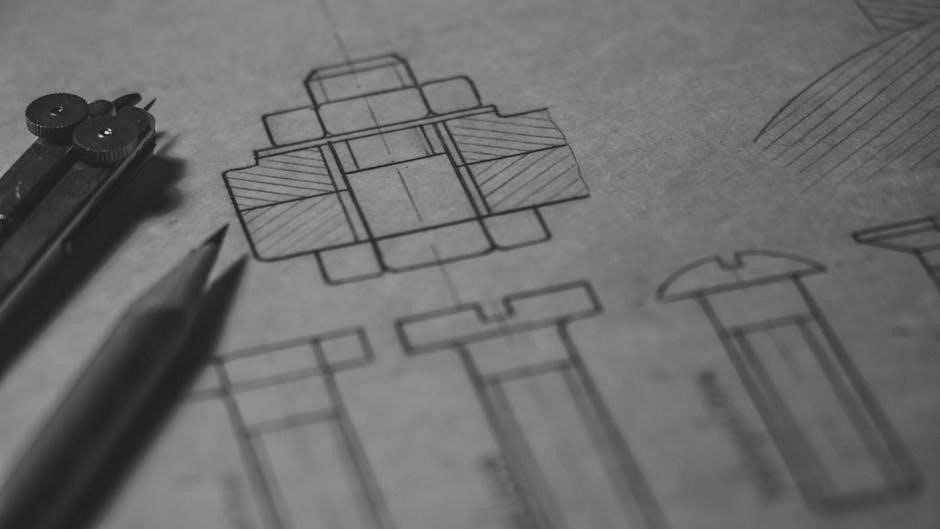
Understanding Wiring Diagrams for Manual Transfer Switches
A wiring diagram simplifies the process of connecting power sources and loads. It uses symbols and lines to represent wires, switches, and circuit breakers, ensuring safe and correct installations.
3.1 How to Read a Wiring Diagram
Reading a wiring diagram involves identifying symbols, lines, and connections. Start by locating the power source, usually a generator or main panel. Follow lines to switches and loads. Understand standard symbols like circles for switches and rectangles for circuit breakers. Colors indicate live, neutral, and ground wires, ensuring safe connections. Diagrams outline proper sequencing and safety protocols for efficient installation.
3.2 Common Symbols and Notations Used
Wiring diagrams use standardized symbols to represent components. A circle often denotes a switch, while a rectangle represents a circuit breaker. Lines symbolize wires, with arrows indicating direction. Colors like black (live), white (neutral), and green (ground) differentiate wire types. These symbols simplify understanding and ensure accurate connections between generators, panels, and loads, promoting safe and efficient installations.

Installation Requirements for a Manual Transfer Switch
Ensure compatibility with generator ratings and electrical systems. Install near the main service panel for safe power routing. Use pre-wired kits with circuit breakers and mounting hardware.
4.1 Pre-Installation Checks and Safety Measures
Before installing, verify the manual transfer switch’s compatibility with your generator and electrical system. Ensure all components are rated for the intended load. Disconnect power sources and test circuits for voltage. Wear protective gear, including gloves and safety glasses. Follow NEC guidelines and local codes to ensure compliance. Double-check wiring diagrams for accuracy and safety.
4.2 Tools and Materials Needed
Essential tools include screwdrivers, wire strippers, and a multimeter. Materials required are the manual transfer switch, circuit breakers, and compatible wiring. Ensure the switch is pre-wired for simplicity. Mounting hardware and connectors are also necessary. Refer to the wiring diagram for specific component placements and connections, ensuring all parts align with the system’s specifications and safety standards.
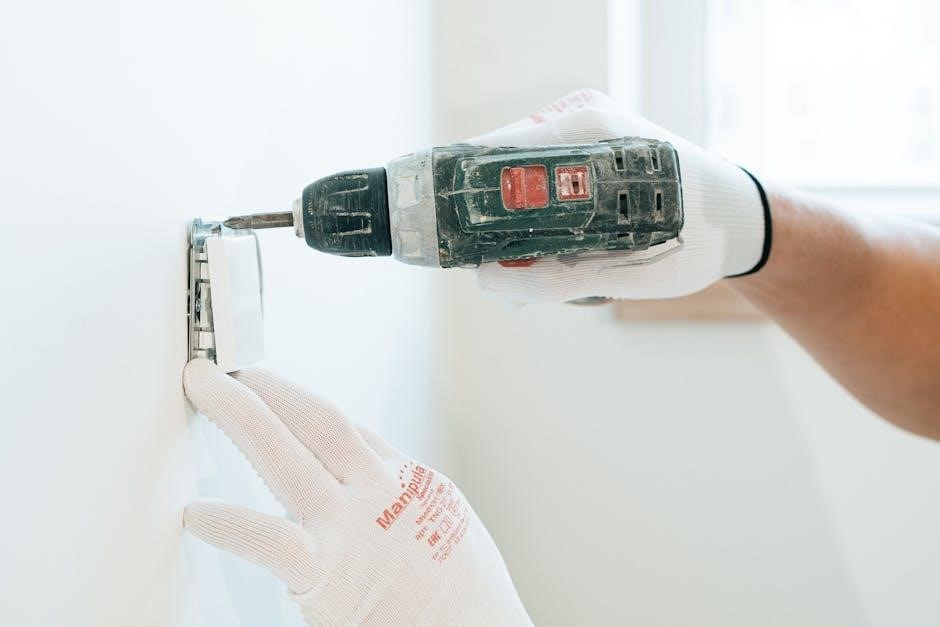
Step-by-Step Wiring Process
Connect the power source to the switch, ensuring secure wiring. Proceed to wire the load side, following the diagram for safe connections. Complete with proper grounding.
5;1 Connecting the Power Source
Connecting the power source involves linking the main electrical supply to the transfer switch. Ensure the circuit breaker is switched off before starting. Identify the incoming wires and connect them to the switch’s terminals as per the wiring diagram. Use appropriate connectors to secure the wires firmly. Double-check connections to avoid any short circuits or electrical hazards. Proper connection ensures reliable power transfer during outages.
5;2 Wiring the Load Side
Wiring the load side requires connecting the transfer switch to the electrical panel or specific circuits. Identify the load wires from the panel and attach them to the designated load terminals on the switch. Ensure proper insulation and secure connections to prevent electrical hazards. Use the wiring diagram to verify terminal placements and connections. Double-check all wires before restoring power to ensure safe and efficient operation.
5.3 Ensuring Proper Grounding
Proper grounding is essential for safety and functionality. Connect the grounding wire from the transfer switch to the grounding bus bar in the electrical panel. Ensure all connections are secure and free from corrosion. Verify that the grounding path is continuous and meets local electrical codes. A proper ground ensures safe operation and protects against electrical shocks and equipment damage.
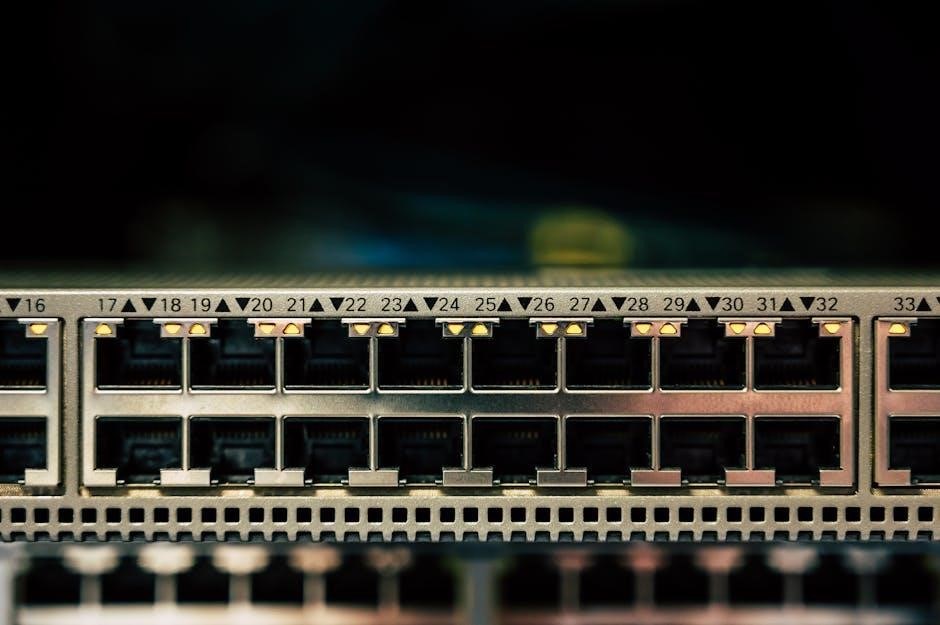
Safety Considerations
Safety is crucial when working with manual transfer switches. Always follow wiring diagrams and manufacturer guidelines to prevent electrical hazards. Ensure proper grounding and avoid overloaded circuits to maintain safety standards.
6.1 Electrical Safety Tips
When working with a manual transfer switch, always disconnect power sources before installation. Use insulated tools and follow the wiring diagram to avoid short circuits. Ensure proper grounding to prevent shocks. Never overload the switch, and regularly inspect connections for wear. Always adhere to local electrical codes and manufacturer guidelines to ensure safe operation and compliance with safety standards.
6.2 Avoiding Common Mistakes
- Avoid incorrect wiring connections by strictly following the wiring diagram.
- Never overload the switch beyond its rated capacity.
- Ensure all connections are secure to prevent loose contacts.
- Do not bypass safety features or skip grounding procedures.
- Verify compatibility of the switch with your generator and electrical system.
- Always turn off power sources before performing any maintenance or repairs.
These tips ensure safe and efficient operation of your manual transfer switch.
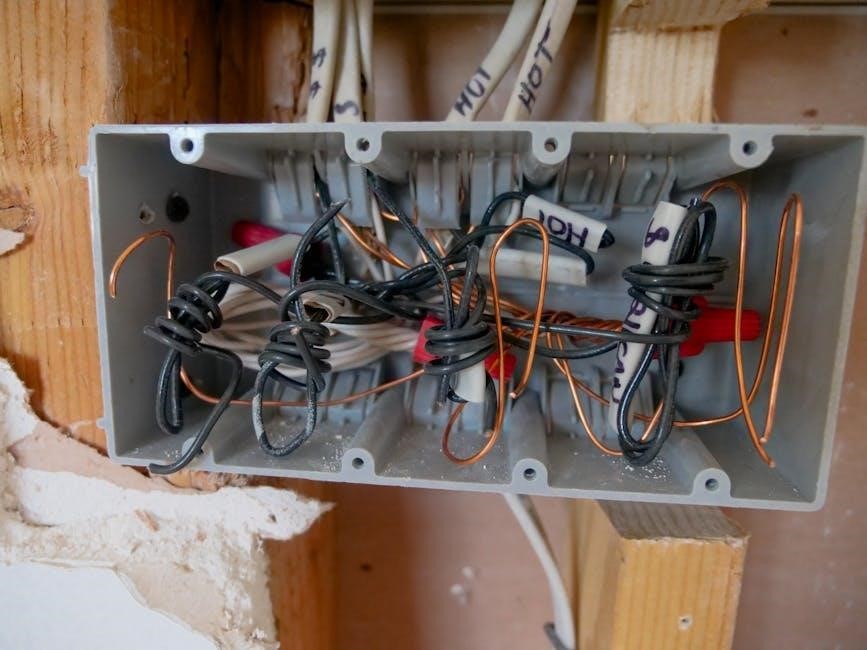
Types of Manual Transfer Switches
Manual transfer switches are available in single-pole and double-pole configurations, catering to different voltage needs. Portable and permanent options offer flexibility for various electrical setups and applications.
7.1 Single-Pole vs. Double-Pole Transfer Switches
Single-pole transfer switches handle single-phase power, controlling one live wire, ideal for basic setups. Double-pole switches manage two live wires, offering better control for higher voltage applications. Both designs ensure safe power switching, with wiring diagrams guiding their installation for reliable operation in residential or commercial settings. Understanding their differences aids in selecting the appropriate switch for specific electrical needs.
7.2 Portable vs. Permanent Installation Options
Portable transfer switches are ideal for temporary power solutions, offering flexibility and ease of use with generators. Permanent installations provide long-term reliability, integrated into electrical systems for continuous backup power. Both options require precise wiring diagrams to ensure safety and compliance with electrical codes. The choice depends on specific needs, whether for emergency backup or consistent power management in residential or commercial settings.

Wiring Diagrams for Specific Applications
Wiring diagrams are tailored for specific setups like home generators or three-phase systems. They ensure safe connections and compliance with electrical standards, preventing installation errors and optimizing performance.
8.1 Generator to Home Wiring
Connecting a portable generator to a home’s electrical system requires a manual transfer switch. Mount the switch near the main service panel and connect the generator’s power inlet. Wiring involves linking the generator’s output to the transfer switch and then to selected circuits. Ensure proper grounding and comply with NEC standards. Always turn off the main breaker before connecting the generator to avoid electrical hazards. Use the correct gauge wire to prevent overheating and ensure reliable power transfer.
8.2 Three-Phase vs. Single-Phase Wiring
Three-phase wiring is used for heavy-duty applications, requiring three live wires and a neutral, while single-phase uses one live wire, one neutral, and a grounding wire. The wiring diagrams differ significantly, as three-phase systems handle higher power loads. Ensure compatibility with the generator and load requirements. Always follow NEC guidelines for safe connections, especially in industrial or commercial settings where three-phase systems are common. Proper installation prevents overload and ensures efficiency.
Troubleshooting Common Issues
Common issues include faulty connections and overloaded circuits. Check wiring diagrams for proper installation. Ensure compatibility with generators and verify switch functionality regularly.
9.1 Identifying Faults in the Wiring
Identifying wiring faults involves checking for loose connections, incorrect wiring, or overloaded circuits. Referencing the wiring diagram ensures proper installation and operation. Faults often arise from misaligned terminals or damaged wires, which can cause power interruptions or safety hazards.
Use a multimeter to test continuity and voltage. Verify compatibility with generators and ensure all connections match the diagram. Regular inspections prevent major issues, ensuring reliable power transfer and system safety.
9.2 Resolving Switch Malfunction
Resolving switch malfunctions starts with disconnecting power and inspecting the wiring diagram. Check for loose connections, damaged wires, or incorrect terminal alignments. Clean or replace faulty components, ensuring proper grounding. Test the switch operation after repairs to confirm functionality. Refer to the manual for specific troubleshooting steps and safety guidelines to restore reliable power transfer and prevent future issues.
Compliance and Regulations
Ensure your manual transfer switch meets NEC requirements and local codes. Compliance guarantees safety and legal installation, avoiding potential hazards and ensuring proper functionality. Always verify standards.
10.1 NEC Requirements for Transfer Switches
Manual transfer switches must comply with NEC standards to ensure safe and legal installations. Proper sizing, ratings, and installation practices are mandated. The NEC requires dedicated neutral conductors and correct grounding methods. Transfer switches must be listed for their intended use and installed in accordance with manufacturer instructions. Compliance ensures safe, reliable power transfer and avoids code violations. Always verify local regulations for additional requirements.
10.2 Local Electrical Codes and Standards
Local electrical codes and standards must be adhered to when installing a manual transfer switch. These codes often include specific requirements for wiring, permits, and inspections. While NEC standards provide a foundation, local regulations may impose additional or stricter guidelines. Compliance ensures safety, avoids fines, and guarantees proper system functionality. Always consult local authorities to confirm requirements before proceeding with installation.
Maintenance and Upkeep
Regular cleaning and inspection of the manual transfer switch are essential. Check for wear, dust, or corrosion. Ensure all connections are secure and functioning properly. Schedule annual testing with a licensed electrician to confirm reliability and safety. Proper upkeep extends the lifespan and ensures optimal performance during power transitions.
11.1 Regular Inspection of the Switch
Regularly inspecting the manual transfer switch ensures optimal functionality. Check for dust, corrosion, or wear on contacts and wires; Verify that all connections are secure and tight. Look for signs of overheating or damage. Ensure the switch operates smoothly between positions. Refer to the wiring diagram for guidance on internal components. Schedule professional inspections annually to maintain reliability and safety.
11.2 Cleaning and Testing the Switch
Clean the switch regularly using compressed air to remove dust and debris. For tougher dirt, use a soft cloth dampened with a mild solvent. Test the switch by toggling it between positions to ensure smooth operation. Check for any signs of wear or arcing. Verify proper electrical connections and use a multimeter to test for continuity. Always follow safety guidelines and refer to the wiring diagram for specific testing procedures.
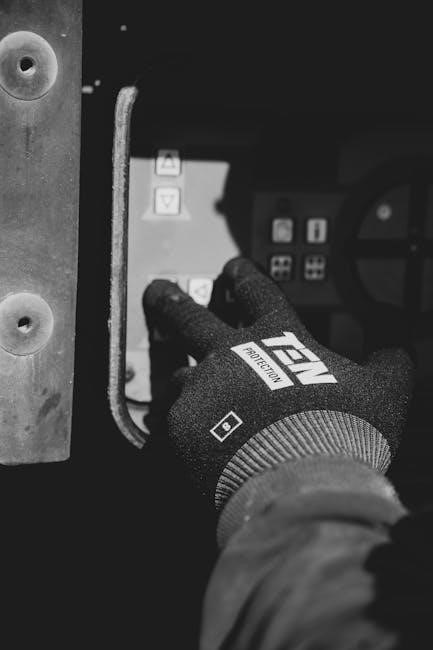
Upgrading Your Manual Transfer Switch
Upgrading your manual transfer switch involves assessing current power needs and ensuring compatibility with modern generators. Always consult a professional to avoid safety risks and ensure compliance.
12.1 When to Upgrade Your System
Upgrade your manual transfer switch when your power needs increase or your current system becomes outdated. Signs include frequent tripping, insufficient capacity for new appliances, or incompatibility with modern generators. Ensure the switch meets updated NEC standards and can handle higher loads safely; Consult a professional to determine the best upgrade path to maintain efficiency and safety.
12.2 Compatibility with Modern Generators
Modern generators often have advanced features like higher power ratings and digital controls. Ensure your manual transfer switch is compatible with these systems by checking voltage and current ratings. Look for switches designed for three-phase or single-phase operations, depending on your generator type. Upgrading to a switch with smart features can enhance functionality and ensure seamless integration with newer generator models.
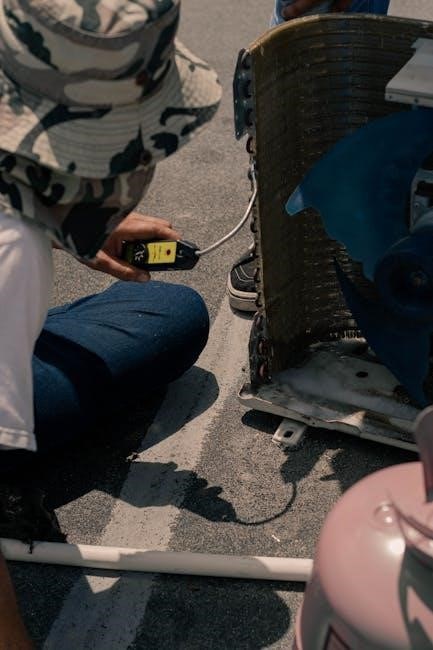
Case Studies and Examples
A residential wiring diagram example demonstrates how a manual transfer switch connects a portable generator to home circuits. This ensures safe, reliable power during outages.
13.1 Residential Wiring Diagram Example
A residential wiring diagram example illustrates how to connect a portable generator to a home’s electrical system using a manual transfer switch (MTS). The diagram shows the MTS installed next to the main service panel, with connections to a 30-amp generator inlet. It includes circuit breakers for individual circuits, ensuring safe and controlled power distribution during outages. This setup prevents backfeeding and guarantees reliable operation.
13.2 Commercial Application Case Study
A commercial case study demonstrates the use of a manual transfer switch in a retail building. The wiring diagram shows the integration of a three-phase generator with the MTS, ensuring seamless power transition during outages. The system includes multiple circuit breakers and load centers, providing reliable power distribution to critical systems like lighting and HVAC. This setup ensures business continuity and operational efficiency.
Frequently Asked Questions
Users often inquire about wiring diagrams for manual transfer switches, seeking clarity on connections and safety standards. Common questions include compatibility with generators, installation requirements, and ensuring compliance with local codes. Understanding these aspects is crucial for a safe and efficient setup.
14.1 General Inquiries About Manual Transfer Switches
Common questions include understanding the purpose of a manual transfer switch, its role in generator connections, and how it ensures safe power transitions. Users often ask about compatibility with different generator models, installation requirements, and how to interpret wiring diagrams. Additionally, inquiries about safety standards, load management, and compliance with local electrical codes are frequent. These questions highlight the importance of proper setup and understanding for reliable operation.
14.2 Common Wiring-Related Questions
Common questions include interpreting wiring diagrams, connecting generators to home systems, and ensuring safety. Users often ask about proper wire sizing, grounding techniques, and avoiding short circuits. Additionally, inquiries about troubleshooting issues like power loss or malfunction are frequent. Understanding these wiring nuances is crucial for safe and efficient manual transfer switch installations.
A manual transfer switch ensures safe power switching during outages. Proper wiring diagrams and installations are vital for reliability. Always follow safety guidelines for efficient and secure operations.
15.1 Summary of Key Points
A manual transfer switch is essential for safe power switching during outages. Proper wiring diagrams ensure reliable connections and compliance with safety standards. Understanding switch components, following installation guidelines, and adhering to safety protocols are critical. Regular maintenance and inspection are vital for long-term functionality. Always refer to manufacturer instructions for specific wiring requirements to avoid hazards and ensure efficient power transfer.
15.2 Final Tips for Safe and Efficient Wiring
Always disconnect power sources before starting work. Use appropriate tools and follow NEC guidelines for safe connections. Double-check wiring diagrams to ensure accuracy. Regularly inspect connections for wear or damage. Proper grounding is essential for safety. Avoid overloaded circuits to prevent hazards. Consider consulting a professional for complex installations. Adherence to these tips ensures reliable performance and long-term safety.
Additional Resources
Explore detailed manuals, guides, and online tutorials for wiring diagrams. Visit manufacturer websites like ASCO and Westinghouse for specific models and installation tips. YouTube offers video tutorials, while forums provide troubleshooting advice from experts and DIY enthusiasts. Utilize these resources for comprehensive understanding and practical applications of manual transfer switches.
16.1 Recommended Manuals and Guides
Consult manufacturer-specific manuals like ASCO and Westinghouse for detailed wiring diagrams and installation instructions. Online resources such as YouTube tutorials and forums offer practical guidance. The ASCO Series 300 Manual Transfer Switch Wiring Diagram is particularly recommended for comprehensive understanding. These resources provide step-by-step instructions, safety tips, and troubleshooting advice, ensuring safe and efficient wiring of manual transfer switches.
16.2 Online Tools and Tutorials
Online platforms like YouTube offer tutorials on manual transfer switch wiring, such as the “Electric Manual Changeover Switch Connection” video. ASCO Power Technologies hosts webinars, including one on March 23, covering manual transfer switches. Forums and DIY websites provide step-by-step guides and troubleshooting tips. Interactive wiring simulators and downloadable PDF guides, like the ASCO Series 300 Manual, are also available. These tools help users understand diagrams and ensure safe installations, enhancing their wiring skills and compliance with standards.
Comments